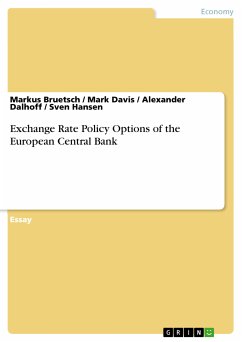
Money Market Interventions (eBook, PDF)

PAYBACK Punkte
0 °P sammeln!
Essay from the year 2003 in the subject Business economics - Banking, Stock Exchanges, Insurance, Accounting, grade: 1,5 (A), Oxford Brookes University (Business School), course: Synoptic Essays in International Banking & Finance, language: English, abstract: After the collapse of the Bretton-Woods-System in 1973 and the transition to a system of floating rates between the major global currencies, central banks still use interventions for exchange rate maintenance. This paper aims to examine the function of Central Bank operations in foreign exchange markets on the basis of two empirical data ...
Essay from the year 2003 in the subject Business economics - Banking, Stock Exchanges, Insurance, Accounting, grade: 1,5 (A), Oxford Brookes University (Business School), course: Synoptic Essays in International Banking & Finance, language: English, abstract: After the collapse of the Bretton-Woods-System in 1973 and the transition to a system of floating rates between the major global currencies, central banks still use interventions for exchange rate maintenance. This paper aims to examine the function of Central Bank operations in foreign exchange markets on the basis of two empirical data sets, explaining both, appreciation and depreciation. It tries to analyse the impacts on capital flows recorded in the balance of payments and the efficiency of interventions. Further it will analyse the impacts on domestic monetary supplies and if necessary how to sterilise these effects. At certain stages endnotes will refer to the appendix for more detailed explanations or data. To illustrate, how central bank interventions work, we will take the European Central Bank (ECB) as an example and concentrate on two currencies, the euro (EUR) and the US dollar ($). [...] If the ECB aims at an appreciation of the own currency, the bank will engage in a foreign exchange operation and buy euros against its US dollar reserves. The demand for euros increases (demand curve shifts to the right) and simultaneously supply is reduced, because the ECB takes Euro out of the market (supply curve shifts to the left). Through the forces of supply and demand the value of the euro will strengthen in international markets (the exchange rate moves from r1 to r2). Depreciation (see diagram 2) If the ECB aims at a depreciation of the own currency, the bank will sell euros against dollars. In this case, demand for euros declines (demand curve shifts to left) and the supply increases (shift to the right) because the ECB pays the purchased dollars in euro. Again, the forces of supply and demand determine the new exchange rate at r2. The value of the euro will weaken in international markets (and inversely the US dollar value will rise). [...]
Dieser Download kann aus rechtlichen Gründen nur mit Rechnungsadresse in A, B, BG, CY, CZ, D, DK, EW, E, FIN, F, GR, HR, H, IRL, I, LT, L, LR, M, NL, PL, P, R, S, SLO, SK ausgeliefert werden.













